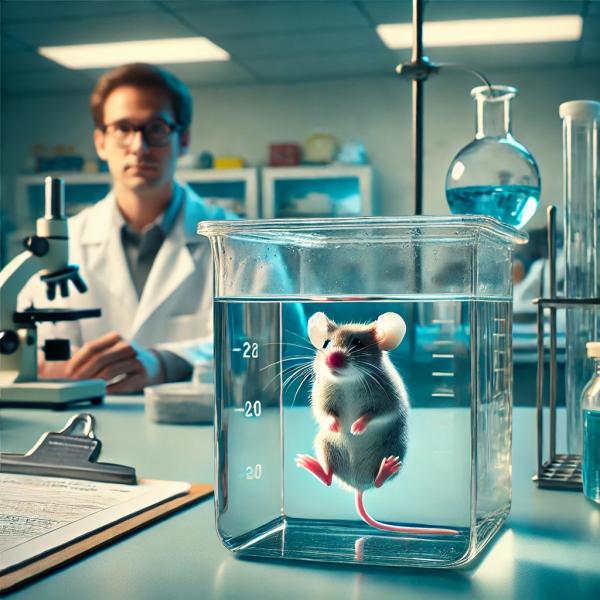
The Forced Swim Test
In the Forced Swim Test (FST), a mouse or rat is placed in a closed container of water from which they cannot escape. The animal initially struggles to escape but eventually gives up and begins immobile floating. Researchers give human antidepressants to some of the animals to see if they struggle and swim longer than those not given antidepressants. The amount of time it takes for the animal to begin immobile floating is supposed to “represent” the mental state of the animal, with depressed animals giving up more quickly than non-depressed animals.
While used to screen antidepressants’ effectiveness, the results have been mixed at best. Some antidepressants increased the struggle time, while others did not. The Forced Swim Test has not been successful at predicting promising new treatments – 92% of psychiatric drugs successful in animal tests fail in human clinical trials.
The reason for the FST’s unreliability in predicting human response to antidepressants has been known for years. A 1989 article demonstrated that the immobility of the animals in the FST is a learned response, with the amount of time the rat or mouse struggles to escape decreasing with experience. The authors concluded that the Forced Swim Test measures “learning to be immobile” instead of “behavioral despair.” Many scientists today consider the behavior of the animals in the Forced Swim Test to be an adaptive response not reflective of depression.
Who No Longer Uses the Forced Swim Test?
The inaccuracy of this test in predicting new antidepressants has led 15 of the leading pharmaceutical companies [1] and two research universities to stop using this test. A 2021 article reviewed 145 studies describing the use of FST by pharmaceutical companies and reported that out of 109 compounds investigated using the test, only seven (3%) were predictive of human depression, and “none are currently approved to treat any type of depression.”
Australia does not allow the Forced Swim Test to be used in any new studies, stating that “The scientific validity of the forced swim test for these purposes is not supported by the evidence,” and they no longer consider it a suitable model for studying depression in humans or anxiety disorders.
The United Kingdom announced its plan to end using the FST in March 2024. They announced that they would reject any applications for projects if the FST were being used as a model of depression or anxiety, and further research should be conducted on non-animal methods for studying depression.
Why Hasn’t the US Moved on?
The National Institutes of Health (NIH), with a 2024 budget of 47.1 billion, is the world's largest funder of biomedical research, funding grants, contracts, and loans responsible for the direction of our biomedical research.
While the NIH states they support “novel alternative approaches” in place of animal research, their actions don’t match their words. They continue a circular argument, saying they will change to non-animal testing after the alternatives are proven. Yet, they reject the alternatives, saying that the data submitted is insufficient.
The NIH continues to fund studies using the FST, with the number of published papers increasing annually. There were 10-15 FST studies in 1985, 300-400 in 2015, and 600 in 2021, even though over 90% of the neuroscience results failed to translate to humans. Scientists know there is plenty of money and grants to continue using the FST, with no incentives from the US government for studying alternatives.
Pharmaceutical companies have stopped using useless animal tests, including the FST because they are responsible for efficiently bringing new drugs to market. When they see a costly, ethically challenged, time-consuming, and unreliable animal test, they stop using it.
The Experimental Animal Industry
Perhaps the reason why the US government continues to fund tests such as the FST is that an entire industrial complex is built around animal experimentation, including thousands of universities and foundations, hundreds of funding organizations, animal suppliers, consultants, scientists, and scientific publishers. Like every issue in Washington, DC, there are trade associations and lobby groups that protect their interests and who argue:
- Although animal tests are not always reliable, no valid non-animal tests replace them. But that is untrue. As I have written, many alternatives to animal tests are in use today, including human cell lines, organoid systems, and computational toxicology
- The advocates who want to stop the use of The Forced Swim Test are not “real” scientists; they are overzealous animal rights activists who value animals over people. Of course, labeling pharmaceutical companies that have stopped using out-of-date animal tests as “overzealous animal rights activists” does not pass the laugh test.
- The Forced Swim Test does not hurt the animals because the tank is heated, the animals do not develop hypothermia, and if at any time the animal looks as though it is struggling to stay afloat, it is taken out of the water. Although the animal is stressed, “gentle drying and warming in a heated holding cage” ensures the animal does not suffer ongoing distress. It warms my heart that the animals are treated so well after their near-death experience.
But let’s not forget – the tests don’t work and are less predictive than flipping a coin.
A body at rest …..
The continued use and funding of the Forced Swim Test begs a larger question – what does it take for our government to stop funding things that don’t work? Is the NIH budget so large that funding useless testing is simply a rounding error? You don’t have to be an animal rights activist to object to tests that don’t produce effective results and waste taxpayer dollars. What will it take for the US to follow the private sector and judge issues based on results rather than continuing the status quo?
[1] These companies include Johnson & Johnson, Bayer, GlaxoSmithKline, AbbVie Inc., Roche, AstraZeneca, Novo Nordisk A/S, Boehringer Ingelheim, Pfizer, and Bristol Myers Squibb



